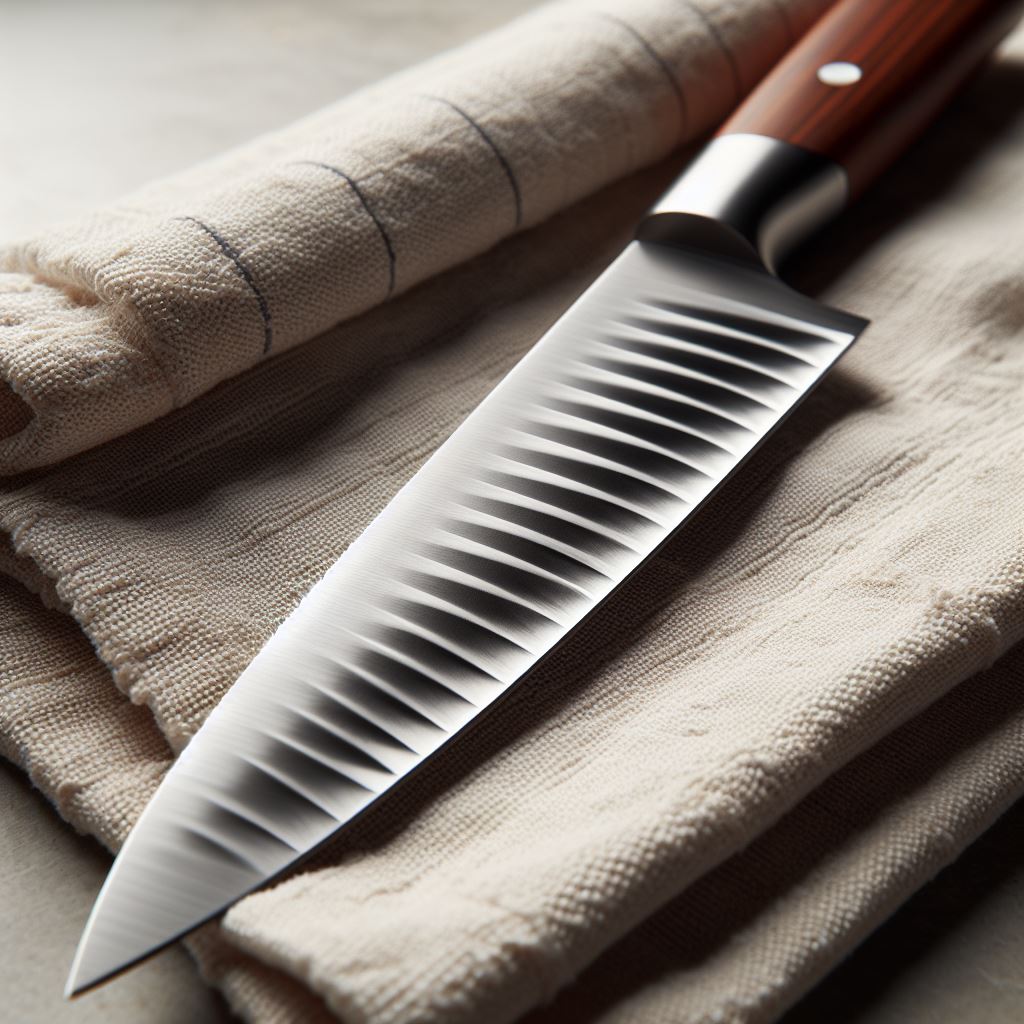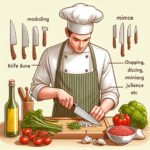A bread knife features a long blade with a serrated edge for cutting through crusts. Its blade typically measures 7 to 10 inches in length.
Bread knives are designed to cut through bread with ease, minimizing crumb dispersion and maintaining the loaf’s integrity. With its sharp, jagged teeth, the knife saws through the bread, allowing users to slice without squashing the loaf. This type of knife is an essential tool in both professional kitchens and home settings.
The serrated edge is also versatile, making it suitable for cutting through other food items with tough exteriors and soft interiors, such as tomatoes or certain types of pastries. A good bread knife balances a comfortable handle with a sturdy, well-crafted blade for efficient and precise cutting.
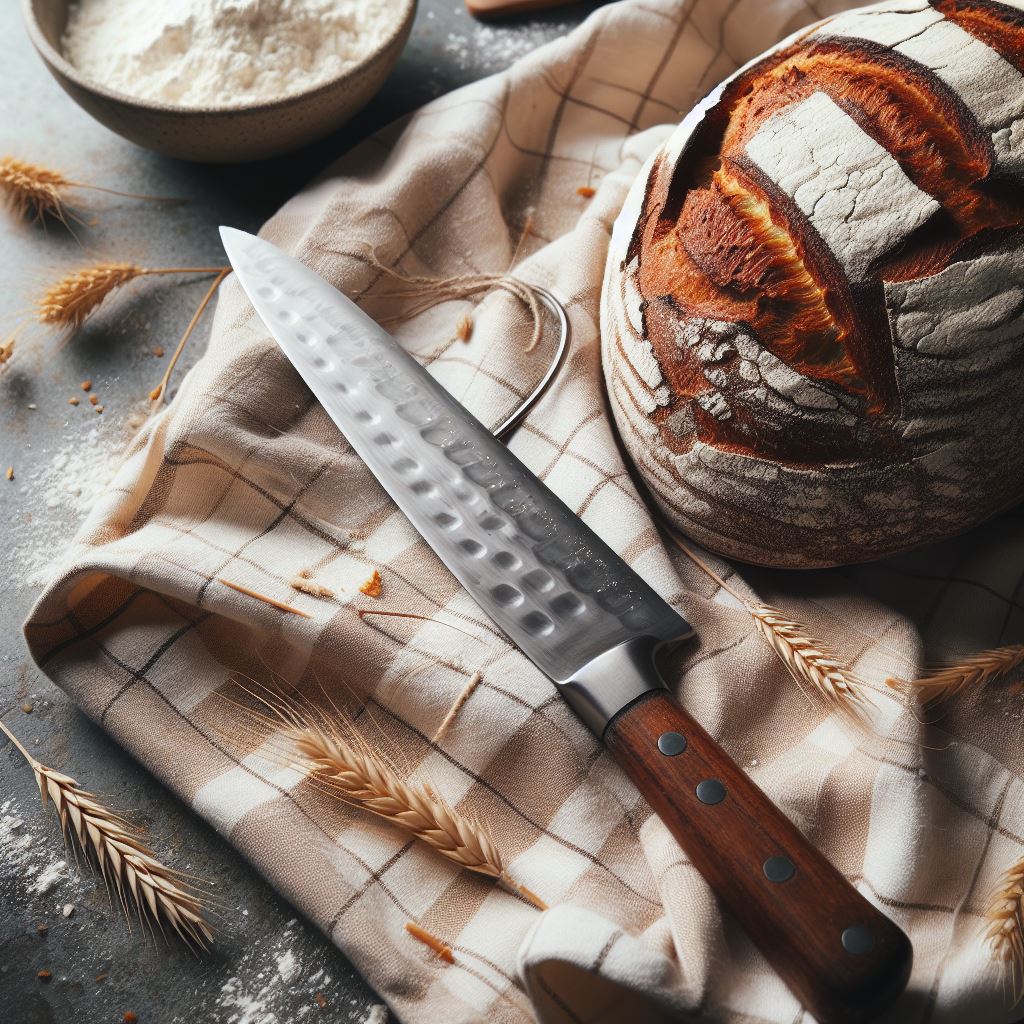
Introduction To Bread Knives
Imagine slicing through a fresh loaf of sourdough—the crust crackling, the soft interior yielding effortlessly. This culinary delight is brought to you by the unsung hero of the kitchen: the bread knife. A bread knife stands apart from its culinary counterparts, designed with unique characteristics that make it a baker’s best friend. Understanding its form and function is key to mastering the art of bread slicing.
Defining Characteristics Of A Bread Knife
What sets a bread knife apart? Here are its defining traits:
- Serrated Edge: Unlike a smooth-edged knife, a bread knife boasts a serrated blade that cuts through crust without crushing the bread.
- Long Blade: Typically between 7 to 10 inches, the length ensures a single cut can span the width of most loaves.
- Offset Handle: Some models feature an offset handle to keep knuckles clear of the cutting board.
These key features allow for effortless cutting and minimal crumbing, preserving the integrity of each slice.
The Evolution And History Of Bread Knives
The bread knife has a storied history, evolving over time to meet the needs of bread lovers everywhere. From rudimentary beginnings to the precision tools we know today, bread knives have undergone significant changes:
| Time Period | Development |
|---|---|
| Pre-19th Century | Early bread knives were simple, often straight-edged, and less efficient for cutting soft bread. |
| 19th Century | Introduction of serrations which allowed bakers to slice without squishing the bread. |
| 20th Century – Today | Refinement of materials and design for ergonomic use and longevity. |
This evolution reflects innovation and the pursuit of creating the perfect tool for bread slicing. Today, the bread knife is not only a testament to culinary innovation but also an essential piece in any kitchen’s arsenal.
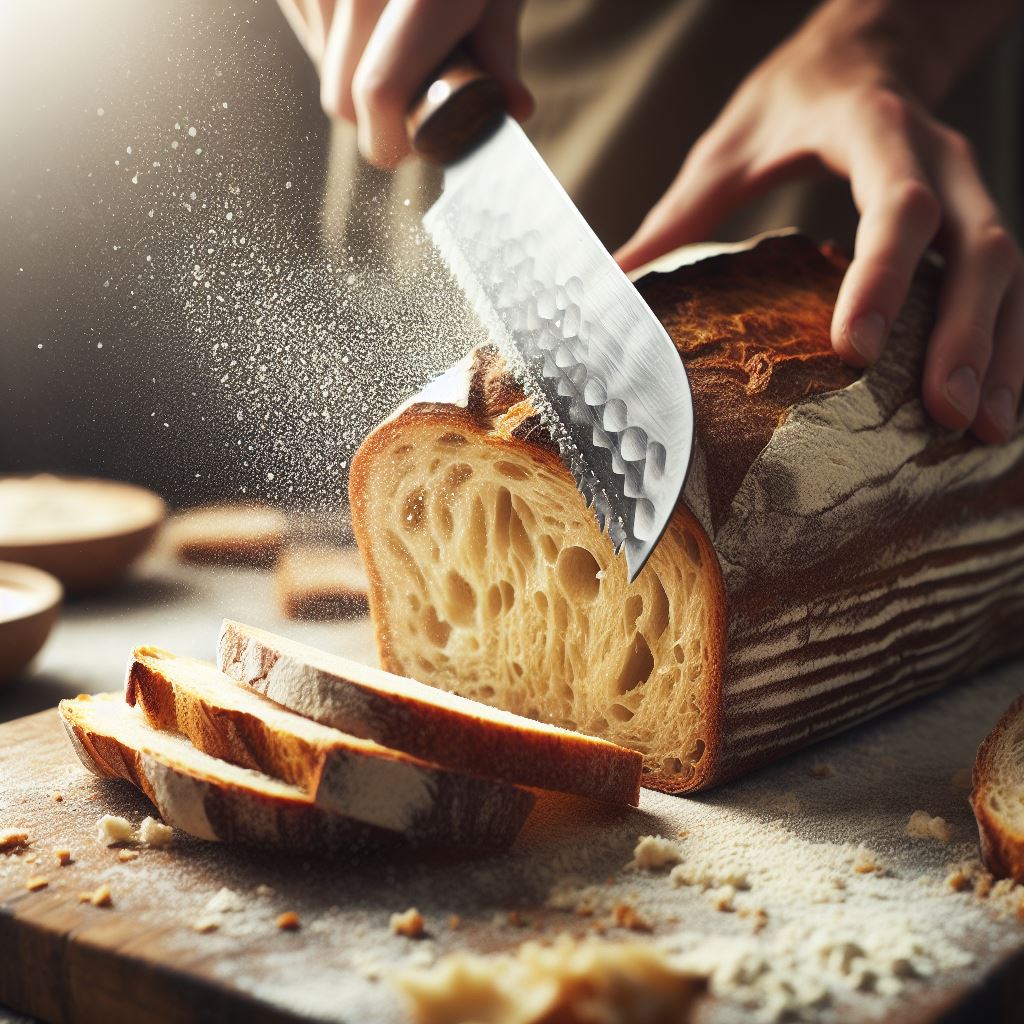
Anatomy Of A Bread Knife
The Anatomy of a Bread Knife isn’t just a matter of esthetics—it’s about precision and functionality. When you wield the right kind of bread knife, every slice you make feels effortless and satisfying. Knowing the components can transform an ordinary bread cutting experience into a culinary triumph.
Blade Design And Materials
The blade, the soul of the bread knife, typically ranges from 7 to 10 inches in length, ideal for different loaf sizes. The materials used for the blade are a crucial aspect of its design. A high-quality bread knife usually features stainless steel or high-carbon stainless steel. These materials are not only durable but also resistant to corrosion and discoloration.
Serrated Edge: Understanding The Teeth
The serrated edge is the crux of the bread knife’s functionality. It resembles the jagged peaks of a saw with “teeth” designed to grip and tear through the tough outer crust without crushing the soft inside. The serrations create a sawing motion, needing minimal downward pressure—a key benefit that preserves the bread’s integrity. The number of teeth and their sharpness determine the efficiency of the cut, contributing to a cleaner and more precise slice.
Handle Ergonomics And Materials
The handle is as important as the blade itself. Excellent bread knives boast an ergonomically designed handle that facilitates a comfortable grip, allowing you to slice with ease for extended periods. Common materials for bread knife handles include wood, plastic, and stainless steel. Many models feature slip-resistant properties to enhance safety. Selecting a knife with the right handle material that harmonizes with your grip can drastically improve your slicing experience.
Using A Bread Knife
A bread knife is an essential tool in any kitchen, adept at handling the delicate task of slicing through various types of bread without crushing the soft interior. With its serrated edge, a bread knife allows for a sawing motion, which cuts through the crust with minimal effort and leaves perfect slices. Let’s delve deep into the proper use of this knife and explore its versatility and maintenance tips.
The Right Technique For Slicing Bread
When it comes to cutting bread, technique matters. To achieve the perfect slice:
- Secure your bread. Place it on a cutting board with the most stable side down.
- Use a sawing motion. Gently move the bread knife back and forth without applying too much downward pressure to avoid crushing.
- Let the knife do the work. The serrated edge should cut through the crust easily, guiding the direction and depth of the slice.
- Slice at your preferred thickness. Continue the sawing motion until the slice is completely separated from the loaf.
By following these steps, you’ll ensure that each slice of bread holds its shape and texture.
Bread Knife Versatility: Other Uses In The Kitchen
A bread knife isn’t just for slicing bread. Its serrated blade makes it incredibly versatile for other kitchen tasks:
- Cutting soft fruits and vegetables. It’s perfect for tomatoes, citrus fruits, and bell peppers, providing a clean cut without squashing them.
- Slicing cakes and pastries. Achieve neat and even layers or portions with ease.
- Leveling off uneven cake tops. Glide the knife over the top for a flat surface perfect for layering or frosting.
Serrated knives like the bread knife can also be ideal for precision tasks, such as creating chocolate shavings or artfully cutting decorative garnishes.
Maintenance And Care For Longevity
To ensure your bread knife lasts for years to come, follow these maintenance and care tips:
- Hand-wash your knife with warm, soapy water rather than using the dishwasher. This protects the blade from harsh detergents and prevents banging against other utensils.
- Always dry immediately after washing to prevent any rust or corrosion.
- Store properly in a knife block, sheath, or designated area away from other utensils to prevent blade damage.
- Sharpen regularly. While serrated knives stay sharp longer, they do need occasional sharpening to maintain optimal performance. Use a sharpening rod or trust a professional.
Caring for your bread knife correctly guarantees that it will be ready and efficient for every slice, no matter the task at hand.
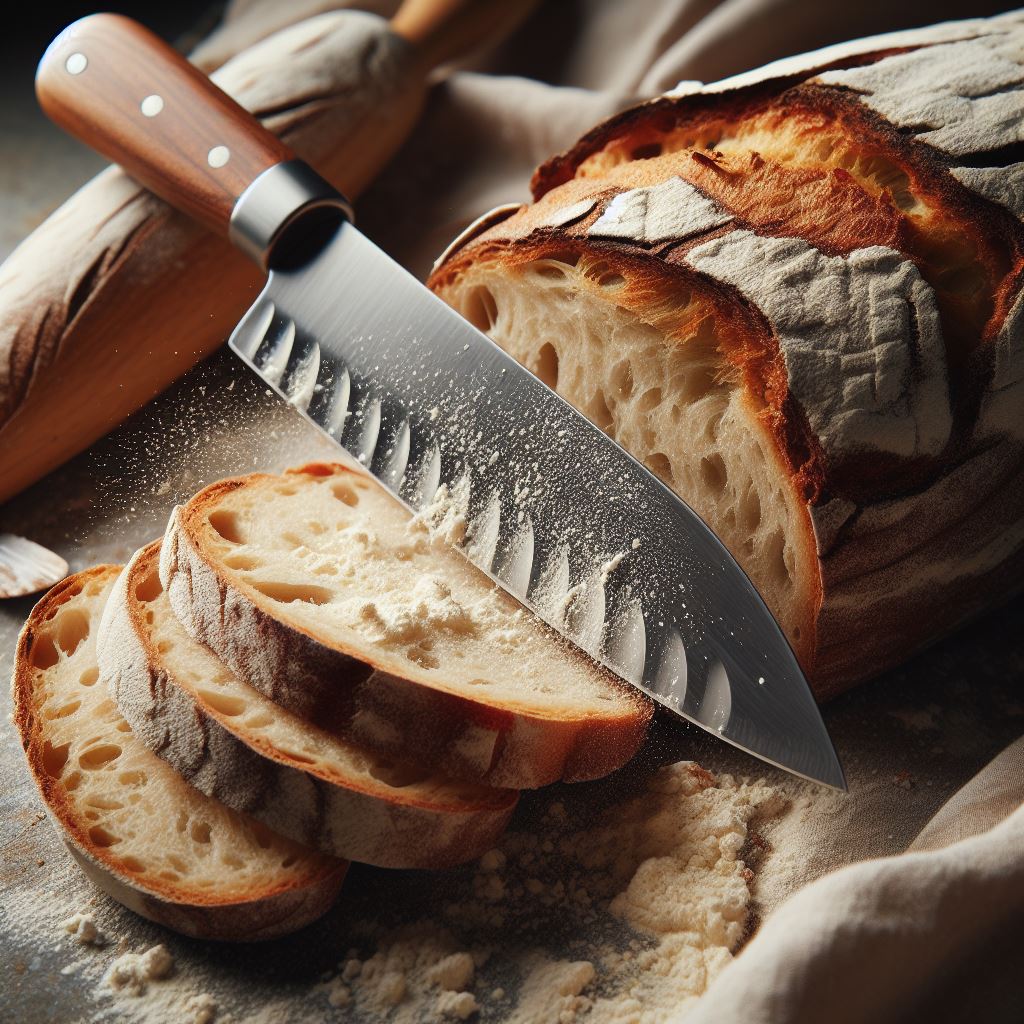
Selecting The Right Bread Knife
A bread knife is an essential tool in any kitchen, adept at slicing through crusty baguettes and tender brioche with ease. When choosing the perfect bread knife, it’s vital to consider factors such as blade length, serration, handle design, and durability. In this section, we’ll slice through the confusion to help you select a bread knife that best suits your kitchen needs.
Factors To Consider When Buying A Bread Knife
- Blade Length: Typically ranging from 7 to 10 inches, the ideal blade length allows for easy maneuvering through different bread sizes.
- Blade Material: Stainless steel is a popular choice for its longevity and rust resistance.
- Serration Pattern: Look for a pointed serration for a better cutting experience.
- Handle Comfort: Ensure the handle feels comfortable and secure in your hand.
- Weight and Balance: A balanced knife will make repetitive slicing less strenuous.
Top Brands And Models
| Brand | Model | Features |
|---|---|---|
| Wüsthof | Classic Ikon | Double serrations for extra efficiency |
| Victorinox | Fibrox Pro | Ergonomic handle, Swiss made |
| Shun | Premier | Beautifully crafted, Japanese steel |
| Global | G-9 | Lightweight, seamless construction |
Price Range And Where To Buy
Expect to find bread knives across a spectrum of prices. For amateur chefs or occasional bakers, knives under $30 might suffice. Mid-range options can cost between $30 to $100, and for those seeking top-tier quality, $100+ knives offer superior materials and craftsmanship.
Kitchen specialty stores and online retailers such as Amazon or Williams-Sonoma provide an extensive selection. Comparing customer reviews and handling a knife in-store, if possible, can greatly inform your chosen purchase.
Conclusion
Understanding the design of a bread knife is key to a clean cut. Its serrated edge and optimal length handle crusty bread with ease. Embrace this kitchen essential for perfect slices every time. Remember, a sharp, sturdy bread knife elevates your bread experience.
Choose wisely and enjoy effortless slicing!
Frequently Asked Questions Of What Does A Bread Knife Look Like
What Are The Characteristics Of A Bread Knife?
A bread knife typically features a long blade with serrated edges. This design enables it to slice through crusty bread without crushing the soft interior. The serrations reduce tearing and provide a cleaner cut.
How Do You Identify A Good Bread Knife?
A good bread knife has sharp, deep serrations and a comfortable handle for a secure grip. It should feel balanced and sturdy, made of high-quality stainless steel, and ideally, the blade length should be around 8 to 10 inches for versatility.
Can Bread Knives Be Used For Other Foods?
Yes, bread knives can be versatile. Besides bread, they are excellent for slicing soft fruits and vegetables, like tomatoes, without damaging them. They can also cut through cakes and pastries cleanly.
What’s The Difference Between A Bread Knife And A Chef’s Knife?
A bread knife is designed with serrated edges for slicing bread, while a chef’s knife has a smooth, sharp edge for versatile cutting tasks. Chef’s knives are more suited for chopping, dicing, and mincing a variety of ingredients.

